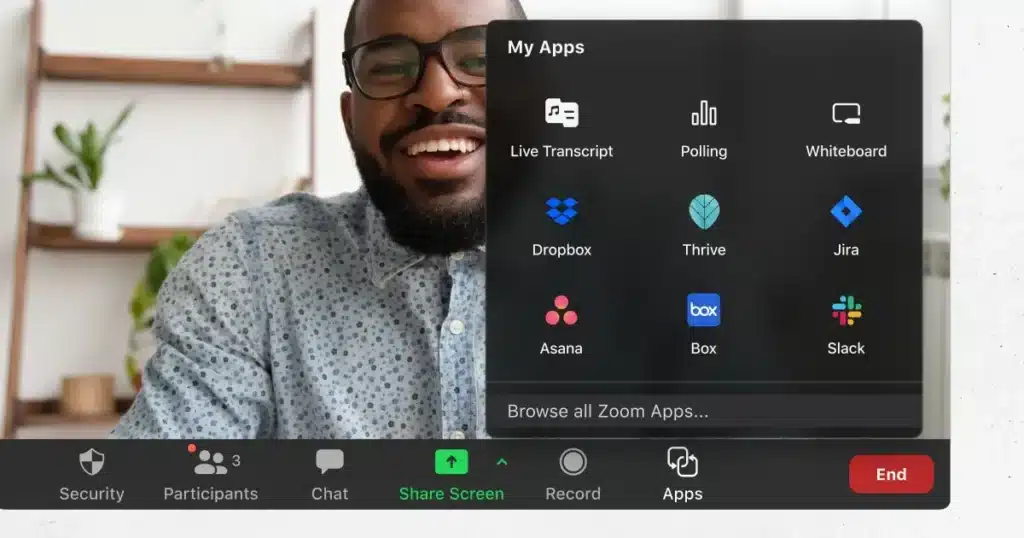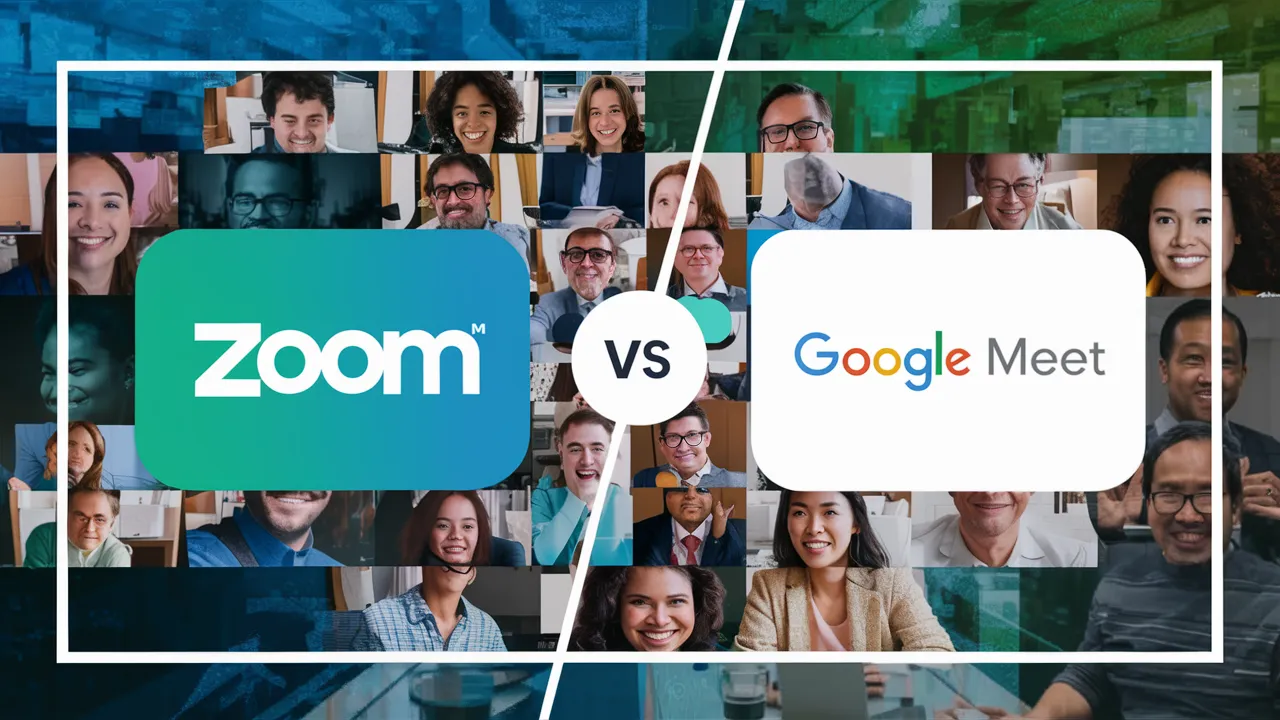Zoom VS Google Meet (previously called Google Hangouts) are among the most popular video conferencing apps used for remote and hybrid work setups. Many people wonder which one is the best and if it truly matters which app they use for online meetings.
Our research shows that Google Meet is the best free video chatting app for individuals and small teams. It’s easy to use and works well with Gmail, Docs, and Drive. If you’re in a big company and need to hold webinars for up to 1,000 people, Zoom is a better choice. It has more features like polls and separate rooms.
Google Meet lets you have video calls with up to 100 people. You can share your screen and see captions in real time. Zoom can handle up to 1,000 people and offers extra features for hosts.
If you just need basic video chatting, Google Meet is cheaper and comes with Google Workspace plans. But if you’re planning big events, Zoom is better. You can learn more about your options with our video chatting quotes tool.
In this comparison, we’ll show the pricing, plans, core features, and additional offerings of Google Meet vs Zoom you may not have thought about!
Google Meet VS Zoom: Big Differences
Honestly, most web conferencing tools offer similar features. They usually include screen sharing, unlimited meetings, customizable layouts, live chat, and connections to other software. But when comparing Zoom vs Google Meet, there are key differences that can help you choose the right one. Here’s a breakdown of those differences.
- Meeting Time Limits: Google Meet’s free plan lets you have unlimited one-on-one meetings, but group meetings of three or more are limited to 60 minutes. Zoom’s free plan restricts all meetings, including one-on-ones, to 40 minutes.
- Accessing the Platforms: You have to download software to use Zoom, while Google Meet can be accessed directly through your web browser.
- Screen Sharing: People prefer using Zoom for screen sharing because it offers a higher resolution (1080p compared to Google Meet’s 720p) and includes a built-in annotation feature.
- Encryption: Zoom provides end-to-end encryption for all meetings, whereas Google Meet plans to introduce this feature by the end of 2022.
- Transcription Services: Zoom offers transcription for $20 per month per host, but Google Meet requires a separate add-on for transcription services.
- Private Messaging: Zoom allows you to privately message a specific participant, but Google Meet doesn’t have this feature.
- Raising Hands: In Zoom, you can raise your hand during meetings for free, but in Google Meet, you need to pay $12 for this feature.
- Availability: Google Meet is readily available for all G Suite users, which means it’s integrated into their workspace alongside Gmail, Google Calendar, Google Docs and – – sheets, and other Google apps. It’s also compatible with Microsoft Outlook emails.
| Qualities | Google Meet | Zoom |
| Price from | $6 per month if you use Google Workspace. | $12.49 per month |
| Best for | Best for Google Workspace users | Beginners |
| Free plan | Yes | Yes |
| Pros | Works well with Google Calendar.Saves chat logs.Simple integration with Google apps. | Easy to use.Offers a feature-packed free version.User-friendly interface |
| Cons | Sometimes has unreliable connections. | The audio quality could be better. |
Capacity

One important thing to consider when choosing a web meeting platform is how many people can join your meetings and how long those meetings can last. For both Zoom and Google Meet, the number of people who can join is similar. In their free and basic plans, both allow up to 100 people, and in their bigger plans, they can have up to 1,000 people.
But Google Meet wins in bigger plans, allowing up to 500 people while Zoom only allows 300. When it comes to meeting time, Google Meet’s free plan gives you 60 minutes, while Zoom gives you only 40. But in paid plans, both offer plenty of time that you probably won’t ever use up.
Integrations
When you’re picking a web meeting tool for your business, it’s important to choose one that works well with your other business tools. Both Zoom and Google Meet can work with lots of other apps, which is good. Google Meet is especially good because it works smoothly with Google apps like Calendar and Gmail.
It also works with Microsoft Office 365 and many other apps like Calendly, Slack, and Discord. Zoom also works with lots of other apps, but it’s not as smooth with Google apps as Google Meet. It can still connect with Google Workplace and Microsoft Office 365, as well as apps like Salesforce and Dropbox.
Additional Features of Zoom vs Google Meet
Both Google Meet and Zoom offer some extra cool features that might make you interested in trying them out. Since they’re competing with each other, they’re likely to keep adding more features, so keep an eye out for updates.
Google Meet, for instance, has a neat live captioning feature. It’s really helpful for people who have trouble hearing, or for those who prefer reading instead of listening during meetings. Zoom also has this feature, along with some others, but Google’s technology makes its live captioning one of the best around.
On the other hand, Zoom has some fun features that make it easy for beginners to use. You can use avatars, change your background, add video filters, and even have in-meeting quizzes. These features make Zoom meetings more enjoyable for everyone.
The best feature of Zoom

Zoom is the easiest video conferencing tool for everyone, especially for those who are new to it. Google Meet might have more business features, but it’s a bit tricky for beginners. Zoom makes things simple from start to finish.
Joining a meeting on Zoom is super easy. You just click the link or type in a short code, like a phone number. Once you’re in a meeting, you can change how the screen looks and share what’s on your screen without any hassle.
The only thing Google Meet has over Zoom in terms of user experience is that you don’t need to download anything to use it – you can just use it in your web browser. But that’s not a big deal compared to how easy Zoom is to use. You just download it once and you’re good to go.
Best for Business: Google Meet
When it comes to business features, Google Meet has the upper hand. It integrates smoothly with Gmail, Calendar, and other apps you probably already use for work. This makes it hard for Zoom to compete.
Google Meet also has some useful business features, like live captioning and saving recordings to Google Drive. These features aren’t just cool—they’re practical for businesses.
Zoom has good business features too, like Multi-Share and Contacts, but Google Meet’s seamless integration with other Google apps gives it an edge. Google is tough to beat in the business world, and video conferencing is no exception.
Google Meet Features
- Live captions while you’re in a meeting
- See a preview of your video and audio before you join
- Change how the screen looks and adjust the settings
- Hosts can control the meeting, by muting or pinning people
- Everyone can share their screen during the meeting
- Chat with others in real time during the meeting
- Connect with Google Workspace and Microsoft Office 365
- Use AI to create new backgrounds
- AI helps capture notes during meetings
Zoom Features
- Choose virtual backgrounds for your video
- Sync your calendar with Google and Outlook
- Use a Waiting Room for extra security
- Share multiple screens at the same time with Multi-Share
- Have your personal meeting room with an ID
- Use “Touch-up My Appearance” for a polished look on camera
- Zoom IQ gives you meeting summaries and helps you catch up afterward
Who can use Google Meet?
Google Meet is perfect for small and big businesses because it works smoothly with Google Workspace. It’s not just for video calls; you also get helpful tools like Gmail, Calendar, and Drive. If you only need a simple solution and don’t plan to grow your business a lot, Zoom might be better. But for most businesses, Google Meet and Workspace are the top choices.
Who can use Zoom?
Zoom is good for individuals and small companies who just want a simple way to talk without extra features. It’s easy for beginners, and the fun quizzes in meetings are great for social events. For business, Google Meet with Google Workspace is strong, but if you prefer something simpler than Google Meet, Zoom is a good choice.
Is Google Meet safer than Zoom?
When it comes to video chatting, safety is crucial. Both Google Meet and Zoom take security seriously, despite past concerns about Zoom. Zoom faced some security issues at the start of the pandemic due to a sudden increase in users. This led to hacks and breaches, resulting in an $85 million settlement. Since then, Zoom has worked hard to enhance security, introducing better encryption and more features.
As part of the settlement, they are also providing training sessions and additional security features. Zoom now offers end-to-end encryption for all users, a crucial security feature. On the other hand, Google Meet doesn’t have end-to-end encryption.
However, both platforms have various security features to keep your video chats safe. So, in terms of security, Zoom is on par with, if not more secure than, Google Meet.
Security Features of Google Meet
- Anti-abuse features like muting participants
- 2-step verification for added security
- Enrollment in the Advanced Protection Program
- Alert Center for monitoring security issues
Security Features of Zoom
- Host controls, including pinning and muting participants
- Personal meeting ID for a personalized touch
- Waiting room to manage entry of new participants
- Single-sign-on for simplified access control
So, which is better: Zoom or Meet
When deciding between Zoom and Google Meet for video conferencing, it ultimately depends on your needs.
Zoom offers a wider range of features such as whiteboarding, private messaging, and higher-quality screen sharing. However, Google Meet is generally simpler to use and doesn’t require a separate app or download. For larger meetings, Zoom might be preferable, while Google Meet is suitable for everyday meetings.
Faq’s
1. Is Google Meet safe?
Your meetings are safe. We have controls to prevent others from joining your meetings without permission, whether you’re using the web, or app, or dialing in from your phone. Plus, when you do things like change backgrounds, conduct polls, or record meetings in Google Meet, your data is stored securely in our top-notch data centers.
2. Which is safer, Zoom or Google Meet?
Google Meet gives you a smooth experience and works seamlessly with all G-suite apps like Gmail, Google Drive, and Google Calendar. On the other hand, Zoom has more advanced features, can host bigger meetings, and has strong security measures.
3. Which is better, Zoom or Google Meet?
In short: Google Meet lets you start instant meetings quickly and easily, while Zoom gives you more options for scheduling and integrates with other tools. Both make it easy to schedule meetings using popular calendars and share links for everyone to join.
4. What are the disadvantages of Google Meet?
Some disadvantages of Google Meet include limits on screen sharing, occasional issues with presentations, fewer features compared to other platforms, restrictions on who can join meetings, limitations on the number of participants shown, restrictions on users from outside your domain, and occasional browser freezing problems.











